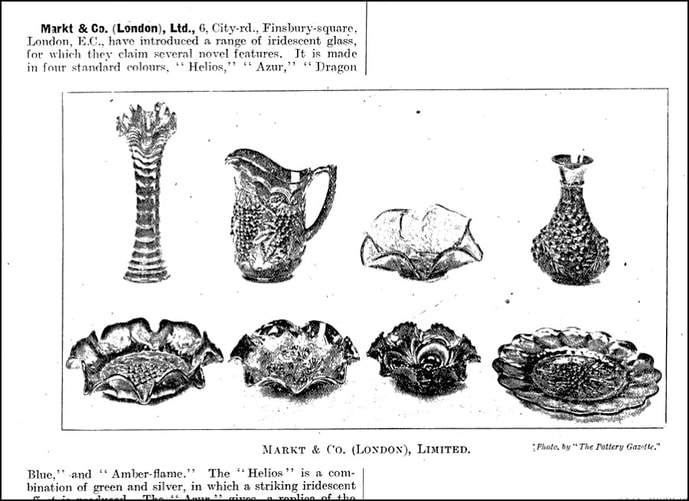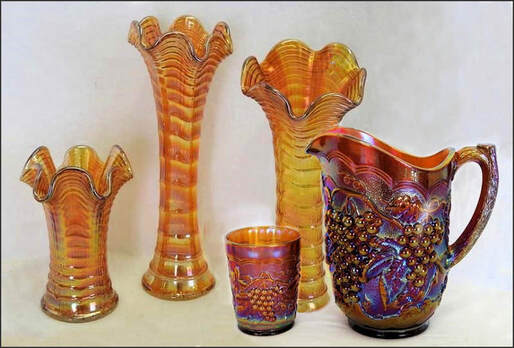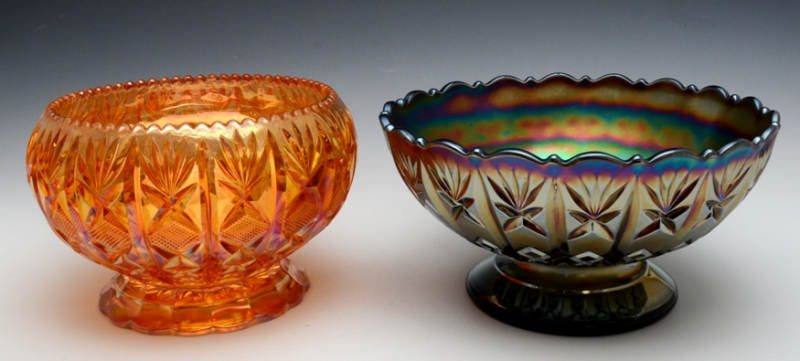NetworK ezine Issue 53. October 2019
Totally Devoted to Carnival Glass
American Iridescent Glass
Picture it, a century ago – a shop window full of shimmering Carnival Glass “decorated all over with rich metallic iridescent blendings, reflecting dark and golden effect, rainbow hues”. Who amongst us hasn’t imagined gathering up armfuls of Carnival from a shop like this in the early 1900s? The image below is, of course, an artist’s impression – but the shop itself (Shaw & Sons) was real, and yes, they had a window packed full of “American Iridescent Glass” that they described as “The Talk of the City”.
Artist’s impression of an early Carnival Glass shop window display*
“The Talk of the City”.
“The Talk of the City”.
|
The city was Brisbane (in Queensland, Australia) and the astonishing window display of “Beautiful American Iridescent Glassware” must have caused a sensation in February 1911. The shop itself, Shaw & Sons, was a “large business in spacious premises” with prestigious showrooms, so this would have been a major sales promotion indeed. The ads for American Carnival continued, with Shaw’s stating a few months later that their large centre window had a “magnificent display of American Iridescent Glassware” including plates, dishes, salad bowls and handled sweet dishes. February, 1911 ad “Brisbane Courier”.
Courtesy of the National Library of Australia Digitised Newspapers. |
Above: “handled sweet dishes, double handled dishes and crimped edge plates” were some of the shapes that were offered by Shaw & Sons. The picture shows shapes, patterns and colours that were available in 1911, and could indeed have been among the items on offer in the Brisbane store. At the back is a Fenton “Vintage” ruffled (crimped) bowl in blue, on the left is a Fenton “Butterflies” bonbon in amethyst and on the right, a green Fenton “Wreath of Roses” stemmed, handled bonbon. Composite image created using pictures courtesy Seeck Auctions and Burns Auction Service.
|
Around 1910, the United States became a net exporter of manufactured goods and International markets beckoned. Australia was a major importer of table and ornamental glassware in 1911, as their own glass industry was in its infancy and was not yet capable of supplying the growing demand of the home market. The way was clear for Carnival Glass – glorious, shimmering, decorative tableware – not only useful but also fabulous to look at.
"Bright and Cheerful without being Gaudy"
Meanwhile, on the other side of the world, just over a year earlier in late 1909, the first shipments of Carnival Glass had been imported into Britain by the agent, Charles Pratt. These were described in the “British Pottery Gazette” as containing glass in “a number of art forms and fancy shapes suitable for presents” and were almost certainly Fenton items. The description went on to describe what we know as Carnival … “the coloured examples are bright and cheerful without being gaudy, while some bowls and other pieces in golden iridescence and in green iridescence, are very effective. Vases and art shapes are shown treated this way.” Charles Pratt was an agent for Fenton, while another agent – Markt & Co. – represented Imperial. And thanks to the reports and ads of the time, we know exactly what Imperial pieces were being imported into Britain.
The amazing archive image above from 108 years ago features a photo of the Carnival Glass that Markt & Co. were offering to the trade. The pieces are all from Imperial and are (top row first, left to right): Ripple vase, Imperial Grape pitcher, Acanthus bowl. Imperial Grape vase (often referred to as a carafe today), Heavy Grape bowl, Pansy bowl, Scroll Embossed bowl and Heavy Grape plate. The grape designs, despite being given two different pattern names by today’s collectors, were almost certainly intended to be part of the same extended line by Imperial.
Of particular interest are the “four standard colours” that the glass was reported to be made in: Helios, Azur, Dragon Blue and Amber-flame. There’s a curious mismatch here to the four colours that were listed by Imperial’s USA agent in 1911, which are shown here: Imperial Glass Ads.
Our suspicion is that the “colours” described by the British agent, Markt & Co., were actually the perceived iridescent effects rather than the actual base glass colours. Helios is straightforward (green base glass with silver or gold iridescence), amber-flame is probably amber base glass, while the azur is most likely purple base glass. But why no mention of marigold (rubigold) … or perhaps that was also included in their descriptive term “amber-flame”?
And what on earth was Dragon Blue?
Of particular interest are the “four standard colours” that the glass was reported to be made in: Helios, Azur, Dragon Blue and Amber-flame. There’s a curious mismatch here to the four colours that were listed by Imperial’s USA agent in 1911, which are shown here: Imperial Glass Ads.
Our suspicion is that the “colours” described by the British agent, Markt & Co., were actually the perceived iridescent effects rather than the actual base glass colours. Helios is straightforward (green base glass with silver or gold iridescence), amber-flame is probably amber base glass, while the azur is most likely purple base glass. But why no mention of marigold (rubigold) … or perhaps that was also included in their descriptive term “amber-flame”?
And what on earth was Dragon Blue?
|
We feel the answer to the "Dargon Blue" question is probably Imperial’s vivid blue-green iridescent effect as seen on purple base glass - it is shown beautifully by this Imperial Heavy Grape plate, courtesy Burns Auction Service.
|
Above: three sizes of Ripple vase in marigold and an Imperial Grape water pitcher and tumbler in amber base glass – both patterns were illustrated in the 1911 report. Courtesy Burns Auction Service.
|
Several Markt & Co. ads for Imperial’s “Iridescent Ware” were featured in the British “Pottery Gazette” later in 1911, and again in 1912. The final one, titled “Our Xmas Offer” appeared in November 1913, as war in Europe loomed on the horizon. International markets were disrupted throughout the years of WWI and it wasn’t until the early 1920s that ads for “Iridescent Ware” appeared again.
We’ll share some of these amazing ads with you in the November issue of NetworK.
Celeste Blue Orange Tree.
An astonishing discovery was reported to our Carnival NetworK Group on Facebook on September 23rd – and we are delighted to have permission to share it with you all here. The owners of this beautiful Orange Tree water pitcher in glorious celeste blue, are Richard Young and Donnie Hazelrigs.
An astonishing discovery was reported to our Carnival NetworK Group on Facebook on September 23rd – and we are delighted to have permission to share it with you all here. The owners of this beautiful Orange Tree water pitcher in glorious celeste blue, are Richard Young and Donnie Hazelrigs.
|
The photo shown on the left is courtesy of Steve Davis. Our sincere thanks to them for sharing. This is the first water pitcher to be reported in celeste blue; the tumbler is already known (in the late Bob Smith Tumbler Collection). Above: a 1912 ad for Orange Tree from china and
glass wholesaler, Falker & Stern of Chicago. |
Fenton’s Orange Tree is a superb pattern (probably inspired by William Morris’s designs featuring this motif in the 1880s and 1890s), and it had a long and popular production span. It first appeared in trade ads around 1912 through to the late 1920s. Celeste blue Carnival was produced by Fenton in the early 1920s, at the same time as red Carnival. Both were made in very limited numbers, and are sought after for their rarity as well as their beauty.
There is much more about Fenton's Orange Tree pattern and celeste blue elsewhere on the website. Here are two links for further reading.
All about Orange Tree: Orange Tree - The Story Behind The Glass.
Celeste blue: Charles Pratt and the Celeste Blue Mystery.
Spotlight on Josef Inwald
Josef Inwald’s glass empire had its beginnings in 1884 – it would grow to six premises across Bohemia, producing and marketing a wide range of glass. The location that is of the greatest interest to Carnival collectors is Rudolfova Hut at Teplice, in Czechoslovakia, which is where some of the most beautiful and artistic Carnival Glass was created, thanks to a combination of high-quality production standards and a master glass designer called Rudolf Schrotter.
Josef Inwald’s glass empire had its beginnings in 1884 – it would grow to six premises across Bohemia, producing and marketing a wide range of glass. The location that is of the greatest interest to Carnival collectors is Rudolfova Hut at Teplice, in Czechoslovakia, which is where some of the most beautiful and artistic Carnival Glass was created, thanks to a combination of high-quality production standards and a master glass designer called Rudolf Schrotter.
|
1997 – we’re given the “brush-off” Our interest in Inwald goes back to the late 1980s-early 1990s. We had written a short article in 1993 for a UK Carnival club newsletter, in which we referred to catalogue pages from Inwald shown in “Collecting Glass Vol 2” -1985 by the late William Heacock (a well-known glass researcher).We felt there was more to delve into and research – and we suggested that Inwald might have produced a substantial amount of Carnival. Alas! We were dismissed and disparaged for our suggestion – and were told by the UK club’s (late) editor that the glass had “French origins” and that we were following a “red herring or perhaps a bandwagon!” Fortunately, we ignored the dismissive advice and ramped up our research into Inwald. A year or two later we teamed up with the late Bob Smith, and together (in our NetworK journal #16, 1997) we laid out the wider truth about Inwald, including the first documentation of many Carnival patterns made by them at Rudolfova Hut. Our close study of many items led us to set out a way we felt that Inwald’s pressed glass could be identified. Here’s a quote from our 1997 research feature: “one of the Signature Characteristics of Inwald’s glass is a mirror shiny, smooth ground base.” Much has taken place in the subsequent two decades, many discoveries of previously unreported patterns have been made, and we have written extensively on the huge output of remarkable Carnival Glass made by Inwald. It’s important to note that Inwald’s Carnival is almost exclusively known in marigold (usually with dazzling or shimmering iridescence) as well as a handful of delicate lilac and pale blue Carnival items. |
Above: a Coronet celery vase in
shimmering pastel marigold. Left: Drapery Variant tumblers. Marigold at either end, and in the centre are the first reported in pale blue Carnival (second left) and (on its right), pinkish-amethyst Carnival. Photo courtesy of the late Bob Smith's Tumbler Museum. |
|
Possibly the best-known Inwald pattern is Jacobean which was subsequently widely imitated.
Inwald themselves named this pattern “Lord”, while the French glass agent, Markhbeinn, called it “Milord”. Inwald’s extraordinarily talented designer, the creative genius Rudolf Schroter, had an innate ability to modify designs to fit many different shapes. The Jacobean pattern is known in around 20 to 30 different shapes in Carnival, while in clear (crystal) glass it is known in around 250 different shapes! Above: Jacobean decanter, courtesy of the late Michael O’Brien.
|
Above: extract from 1928 Markhbeinn catalogue featuring Inwald’s glass.
They were depicted in “Ambre Irisé” – marigold Carnival Glass. |
|
A number of Inwald’s popular designs were imitated by other makers – Imperial, for example, copied Inwald’s 1921 Jacobean design with their Ranger pattern in 1922. Diamond Cut is another fascinating example. Made by Inwald in the form of Carnival vases, jardinière, rose bowl and celery, the pattern was copied by Crown Crystal in Australia as well as Hortensja in Poland and probably an (as-yet-unknown) South American maker. Shown on the right are two Diamond Cut pieces in the large rose bowl shape. The marigold one to the left of the picture is Inwald’s version and on its right is the Crown Crystal example in purple. Photo courtesy of Neil Ritchie. We have a new feature article about Diamond Cut here: Diamond Cut (Part One). |
|
Contemporary Carnival
We have a lot of information about Contemporary Fenton Carnival on our website, and we are adding to it regularly. Here are our latest additions. Fenton Recently, on our Carnival NetworK Group on Facebook, Cindy Garner posted pictures of her beautiful Fenton Candy Box for identification. It intrigued us, and started us on a new line of research. We found the piece in Fenton's 2002 catalogue, in which they showed a selection of pieces in an iridescent colour / treatment they called "Sunset Stretch". Fenton called the pattern Panelled Grape. But the research didn't end there. In our records, we found a picture of the actual mould that Fenton used, and we traced its history back to Westmoreland. It was used extensively in the 1950s-70s by Westmoreland to make their ever-popular milk glass. It was their pattern number 1884 which they called Beaded Grape, part of their extended Paneled Grape range. Our website article includes the Fenton and Westmoreland catalogue images, pictures of the moulds and their history. All thanks to Cindy's posting in our NetworK Group on Facebook! Here is the article: Fenton's Sunset Stretch. The page also has links to all the other Fenton Contemporary Carnival catalogues on our website. If you want to join our very active Facebook Group, the details are at the bottom of this Issue. L. E. Smith |
Above: Paneled Grape in Sunset Stretch, by Fenton.
Photo courtesy of Cindy Garner. |
|
Moon and Stars in Ruby Carnival.
|
When we were researching for our second Schiffer book - A Century of Carnival Glass - we were in contact with many of the glassmaking companies around the world that were still in business. One of them, L. E. Smith Glass Co., sent us material that included two catalogue pages of their Contemporary Ruby Carnival. Moon and Stars (shown here on the left) and other popular Smith patterns were featured. You can read about L. E. Smith' Contemporary Carnival, including the catalogue pages, here: L E Smith's Ruby Carnival. |
* This is an artist’s impression of what a shop window display full of Carnival Glass might have looked like, back in 1911.
The items featured in the artwork are representative of the patterns, shapes and colours that would have been available at that time. The shop – Shaw & Sons – was an actual retail establishment in Brisbane, Australia, that sold Carnival. However, the illustration is not intended to depict that actual store, it is simply an artist’s rendition and the appearance is, of course, conjecture.
The items featured in the artwork are representative of the patterns, shapes and colours that would have been available at that time. The shop – Shaw & Sons – was an actual retail establishment in Brisbane, Australia, that sold Carnival. However, the illustration is not intended to depict that actual store, it is simply an artist’s rendition and the appearance is, of course, conjecture.
Privacy and the use of your information: we only use your name and email address to send you your FREE Carnival Glass NetworK ezine. We will not share your name or email address with anyone else, or use it for any other purpose. You can change your mind about receiving your NetworK ezine at any time by clicking the unsubscribe link at the foot of every issue, or by emailing us at [email protected]
Join us on Facebook
We invite you and your friends to join us all on NetworK's fast growing and very active Facebook Group (link is below), and if you have missed any of the previous issues of NetworK and NetworK Specials, they are all here: Back Issues.
We invite you and your friends to join us all on NetworK's fast growing and very active Facebook Group (link is below), and if you have missed any of the previous issues of NetworK and NetworK Specials, they are all here: Back Issues.

















